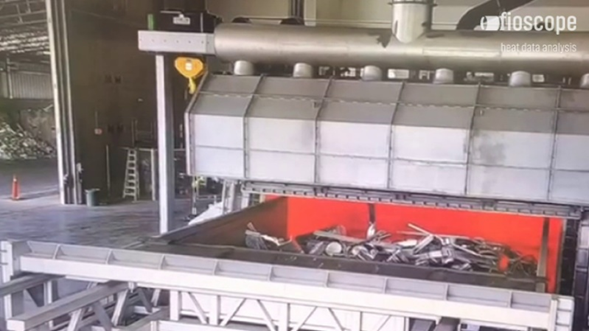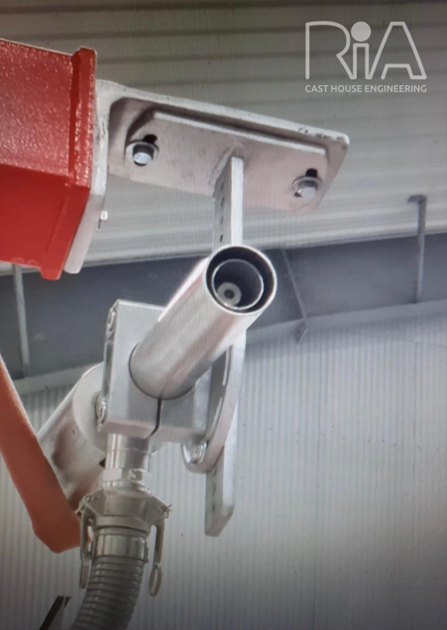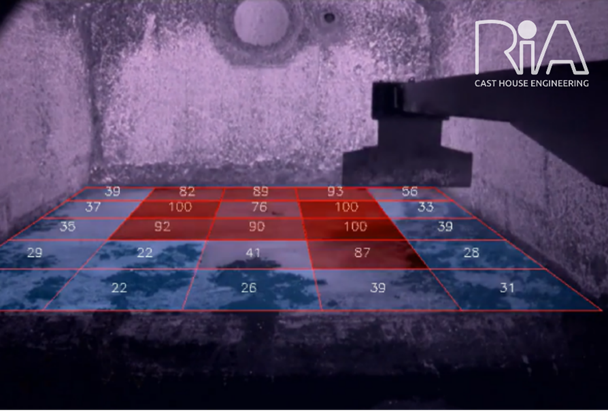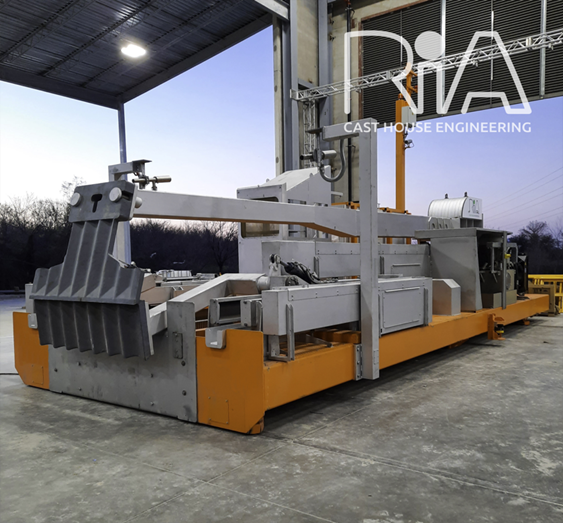

Introduction
RIA Cast House Engineering provides precision rail-mounted casthouse-proven charging and skimming equipment for aluminium casthouses worldwide. The design and development of all RiA Machines take reliability, durability, maintenance, and occupational safety into account. RiA has supplied over eighty furnace charging and skimming machines, all rail-mounted and capable of charging up to 30 metric tonnes in less than 90 seconds or skimming a furnace faster than a traditional forklift truck or wheeled furnace tending vehicle, but with more repeatable results and without damaging the refractory lining. Key customers include Hydro, Constellium, Matalco, and many others. Several clients have multiple machines in the same casthouse or across various sites and territories. One client alone has implemented over thirty RiA Machines in ten countries.
{alcircleadd}In recent years, in conjunction with our exclusive partner Fioscope GmbH, RiA added the innovative capability of AI Smart camera-based decision-making to our machines to offer fully autonomous operation and, therefore, remove the requirement to have operators on or near our machines. RiA’s Managing Director, Michael Rockstroh, also became Managing Director of Fioscope GmbH in February 2022, helping to drive the continuous development of RiA’s AI-enabled autonomous machines and assuring our growing customer base that RiA equipment is not only suitable for today but also tomorrow and beyond.
Autonomous furnace charging operation maximising safety and productivity
In typical operations, the melt cycle cannot be observed without opening the door and losing heat and energy, as well as the associated safety risk to the operators. Therefore, valuable minutes can be lost if the furnace is ready to receive the next charge, but the operators are unaware since the contents are not visible. For several years, RiA has integrated Smart Cameras onboard its Machines and in furnaces to enable autonomous operation. Significant advances in process control are then possible using air-cooled smart cameras. High-temperature-resistant cameras allow for real-time observations of melt progress. They provide a safe and real-time process development benefit that was in the past impossible even to observe, let alone monitor, without opening the furnace door.
RiA’s Intelligent Camera monitor the progress of the scrap pile as it melts. The camera determines the earliest possible moment in which the charging machine can deliver the next charge. Through this, autonomous operation is possible. Figure 1 shows 3 still Images taken for the purpose of this article from the operator station at one of RiA’s fully autonomous charging machine installations. Three different stages of the melt cycle are shown, following a charge. The first image shows the furnace with a scrap pile that has recently entered the furnace; using a ‘traffic light’ visual for the operators, the intelligent cameras not only relay the image but also highlight using the red light that the furnace is not ready to receive the next charge.
A yellow signal on the second image indicates that the intelligent cameras detect that the scrap pile has lowered in height and is, therefore, getting closer to the point at which RiA’s charging machine can enter the furnace without contacting the scrap pile. Operators are now alerted to the fact that within the next few minutes, they must conclude loading the container to ensure RiA’s Charging Machine can deliver the next charge at the earliest possible moment, ensuring valuable production time is utilised.

Fig 1: Screenshots of RiA’s Intelligent Cameras relaying real time information of melt progress to the Cast House.
Finally, the third image and green light indicate that the furnace is ready to receive the next charge. Previously, the furnace door would need to be opened for the operators to confirm this information and make informed decisions, but in this case, RiA’s Intelligent Cameras detect the scrap pile is now low enough for the charging machine to enter, deposit the next load and retract from the furnace without contacting the scrap already inside. Whilst ensuring maximum productivity through charging at the earliest appropriate time, there are also significant safety benefits as the requirement to open the furnace door is significantly reduced, combined with giving operators the assurance that they are not charging the next load into liquid aluminium. As operators are shown the time period they have to ensure the charging machine is loaded, this helps to ensure the furnace contents will not be in a molten state, an important safety feature of high value to many of RiA’s customers.
No time is lost during the charging phase of the melt cycle, ensuring maximum productivity for your casthouse. Once the charge machine is loaded, operators can complete other tasks as RiA’s Intelligent Cameras trigger the cycle to begin, requiring no further operator interaction. Once the cycle is complete, the RiA Charging Machine moves back to the loading position to prepare for the next charge. As Figure 2 shows, the furnace charging cycle can be viewed safely from the monitor in the operator pulpit via another camera mounted at the rear of the machine.

Fig 2: RiA’s On-Board Camera monitoring the Furnace Charging cycle, relaying the footage to operators who can be situated in the safety of the operator pulpit.
Even if you do not yet operate RiA’s charging and skimming machines, using our In-Furnace Vision technology would allow you to safely recognise when it is the optimum time to charge your furnace, knowing that you are doing it at the earliest and safest time, every time.
In summary, smart cameras reduce unnecessary door openings, shorten cycles and save energy. These systems can increase safety and potentially avert accidents. Smart Cameras also allow the melt cycle to be optimised, ensuring charging can take place safely at the first opportunity. Furnace Monitoring Systems allows playback, troubleshooting, and diagnostics. It is believed that in the future, all new Furnaces will incorporate In-Furnace Cameras. Contact RiA to find out how we can help optimise your operation.
Autonomous skimming, maximising productivity and safety
In typical operations, melting and holding furnaces are skimmed by either a wheeled vehicle or a rail-mounted machine. Typically, both are driven by an operator present on board the machine to give them a direct view into the furnace to locate the dross to skim from the melt surface.
The above process presents two main concerns for the aluminium casthouse. The first concern being that operators have to be on board the machine, exposed to the heat and potential dangers of molten aluminium. Secondly, operator-driven wheeled vehicles typically have long skim booms that move with little control or precision when skimming the furnace. Often, this causes unnecessary damage to the refractory lining within the furnace, leading to the earlier replacement of refractory walls and the furnace sill and lintel. Not only does this incur the cost of replacing the refractory lining more frequently, but also the lost production time with the furnace being down to conduct the necessary repairs, often for several weeks.
To address the historical issues with Furnace Skimming, in 2019, RiA Introduced Fioscope’s Air-Cooled Smart Cameras on board our skimming machines, as shown in Figure 1. The cameras are air-cooled to manage the radiant heat from the furnace, which operators would typically be exposed to.

Fig 3: Fioscope’s Air-Cooled Smart Camera Technology for High Temperature Applications, onboard a RiA rail-mounted Skimming Machine.
Camera images are relayed to the operator's pulpit, and the operator can watch the skimming cycle from a safe location, away from the furnace. RiA skimming machines have been capable of automatic skimming for some years. Through precise position measurement and control, it is possible to follow a predetermined skimming pattern, lane-by-lane, to remove the dross from the furnace without contacting or damaging the refractory or the need for an operator to be onboard the machine. However, the machine will skim the entire surface of the bath regardless of the location of the dross, or if the dross moves into an already clean and previously skimmed lane, the machine is effectively blind and will not react. The solution was to install Smart Cameras on the Skimming Machine that have a view of the bath surface. The cameras identify the difference between dross and a clean surface, drive the skim blade to the location of the dross, and remove it from the furnace.
Figure 2 shows the Smart Cameras automatically recalculating the bath cleanliness based on the image from the camera. Using an internal neural network, RiA train the Cameras to differentiate between a dross layer and the molten aluminium. With a predetermined desired cleanliness, RiA's Skimming Machine will autonomously skim the bath until this cleanliness percentage is achieved across the grid overlayed onto the bath surface. Smart Cameras allow for recalculation if a dross were to move past the skim blade as it moves through the dross layer, something that a blind robotic machine does not see. Smart Cameras mounted on RiA's skimming machine also set the depth of the skim tool, ensuring it is at the optimum depth to skim the dross from the melt surface.
Once again, all of this is possible without human interaction other than initiating the cycle. Even then, if the Furnace contains RiA In-Furnace Smart Cameras, they can determine when flat bath conditions are achieved and ready for skimming. Having established these capabilities, all RiA Charging and skimming machines sold in recent years were either sold with fully autonomous capability or were built in such a way that this could easily and modularly be added at a future date.

Fig 4: RiA’s On-Board Smart Cameras calculating bath surface cleanliness in real time during the skimming process.
This fully intelligent capability is already implemented in several casthouses worldwide and significantly in the European and US markets. The machine will not only skim, but also stir and mix the bath contents as well, to ensure Homogeneity and can also clean the refractory between cycles or alloy changes. In this final case, the Blade needs to contact the refractory, but because the refractory locations have been programmed into the PLC, the approach speed and pressure of contact are reduced, minimising refractory wear and damage.
All RiA machines incorporate accurate laser position sensors and Laser safety scanners. As they are rail mounted, all casthouse personnel are aware of the possibilities and direction of movements. Even then, if a person or an object is in the path of movement, the machine will slow down and stop without contacting the object in its path.
The benefits of implementation of such technology in your casthouse include:
The vision of a smart casthouse with operator safety a high priority is no longer just a vision for RiA, but already a reality.
RiA exclusive patent – In Furnace Dross Processing (IFDP)
RIA’s next innovation in furnace skimming is a game changer in dross processing. The process of In‑Furnace Dross Pressing (IFDP) is a patented process that increases aluminium recovery and reduces the amount of dross removed from the furnace.
The concept behind the IFDP is to squeeze the dross on the furnace sill before it leaves the furnace and gets too cold or hot to remove all the contained aluminium effectively. The uniquely designed skim blade compresses the dross against the cold plate, removing aluminium and rapidly cooling the dross, preserving metal units. The In‑Furnace Dross Processing is achieved in synchronization with the skimming cycle. The liquid aluminium flows back into the furnace, and the cooled dross is removed in the skim cycle. The skim blade and cold plate are uniquely designed to produce a cooled dross cake with aluminium concentrated on one side and oxide on the other, enhancing secondary recycling. The IFDP cycle is automated and repeated until the furnace is completely dross-free.
The IFDP provides several advantages compared to traditional technologies. Most important is the reduction of metal losses at its occurrence. Up to 80 % of the liquid metal contained in the dross flows back into the furnace and does not need to be processed or re-melted. Furthermore, the dross will be cooled immediately during pressing. This reduces additional metal losses. The skimming cycle is minimally extended by the IFDP system in.

Figure 5: RIA Skimming Machine with In-Furnace Dross Press
Summary
The precise RiA skimming machine movements, the programmed contact to the refractory contours, and the adjusted plate pressure to the refractory eliminated collisions with and damage to the refractory lining. This reduces maintenance on the refractory significantly. Using an RIA skimming machine reduces skim cycles, saves energy, and increases occupational safety in all modes of operation because even in manual mode, the operator is protected by an insulated operator cabin.
The AI and IFDP features, in combination with the known advantages of the RIA skimming machine, make this the best technology for furnace skimming.



Responses






